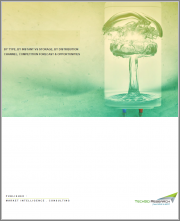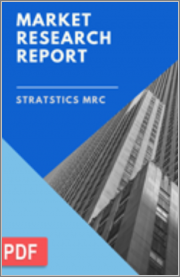
|
시장보고서
상품코드
1362922
미국의 농업용 텍스타일 시장 규모, 점유율 및 동향 분석 보고서 : 재료별, 유형별, 최종 용도별, 부문별 예측(2023-2030년)U.S. Agro Textile Market Size, Share & Trends Analysis Report By Material (Synthetic Fiber, Natural Fiber), By Type (Woven, Non-Woven, Knitted), By End-use (Shade Nets, Mulch Mats), And Segment Forecasts, 2023 - 2030 |
||||||
미국의 농업용 텍스타일 시장 성장 및 동향
Grand View Research, Inc.의 최신 보고서에 따르면 미국의 농업용 텍스타일 시장 규모는 2030년까지 5억 8,470만 달러에 달할 것으로 예상되며 예측 기간 동안 CAGR 3.3%로 성장할 것으로 예상됩니다.
이러한 성장은 농산물 수요 증가와 농업 기술의 발전에 기인합니다.
농업 생산량을 늘려야 할 필요성으로 인해 농업 분야 제조업체들은 토양 첨가제와 같은 전통적인 방법을 대체할 수 있는 방법을 찾게 되었습니다. 농업 활동에 사용되는 천연 자원의 가용성이 제한되어 있고, 많은 농약 등 자재에 대한 관리 기관의 엄격한 규정으로 인해 기술 발전이 농업 생산성을 향상시키는 데 큰 영향을 미치고 있습니다. 최근 몇 년동안 농업 기술의 연구 개발 활동이 활발해지면서 농업용 텍스타일을 새로운 농법에 도입하거나 섬유 자체를 더 효율적으로 개선하여 농업용 텍스타일 사용에 큰 영향을 미치고 있습니다.
자외선 차단, 햇빛 반사, 통기성 원단 등의 특성을 가진 차광망은 온실과 테라스 재배에 사용하기 위해 소비자들이 선택하는 제품입니다.
최근 사용자들은 무비료 재배와 같은 기술로 전환하고 있습니다. 도시화가 진행됨에 따라 농사를 지을 수 있는 땅이 줄어들고 있습니다. 사용 가능한 토지의 성장력과 영양 잠재력이 감소함에 따라 환경에 유해한 대체 화학 물질을 사용하지 않고 수확량을 늘리는 것이 점점 더 어려워지고 있습니다. 농작업의 여러 단계에서 화학비료를 사용하면 농산물의 품질을 떨어뜨릴 가능성이 높습니다. 무토양 재배는 에어로포닉스, 수경재배, 아쿠아포닉스와 같은 기술을 사용하는 제조업체에 적합한 대체 방법입니다. 이는 경작할 수 있는 토지가 한정된 도시 지역에서 효과적입니다.
물, 토지 등 자원의 불확실성과 해충, 기후 변화와 같은 기타 환경적 요인이 결합되면서 농부들은 생산 수준을 유지하기 위해 농업 기술을 활용하고 있습니다. 농업 활동에서의 기술 활용은 작물 수확량을 증가시킬 것으로 예상됩니다. 고품질 식품에 대한 수요 증가는 다양한 농법에서 제품 사용 증가로 인해 미국의 농업용 텍스타일 시장을 견인할 것으로 예상됩니다.
미국의 농업용 텍스타일 시장 보고서 하이라이트
- 합성섬유 부문은 2022년 68.0%의 최대 매출 점유율로 시장을 독점할 것으로 예상됩니다. 폴리프로필렌, 폴리에틸렌, 폴리에스테르와 같은 합성 섬유는 높은 인장 강도와 내구성으로 유명합니다. 농작업 및 환경 조건으로 인한 스트레스를 견딜 수 있어 장기적인 사용에 적합합니다.
- 니트 농업용 텍스타일 분야는 예측 기간 동안 CAGR 3.5%로 가장 높은 성장률을 보일 것으로 예상됩니다. 이는 니트 직물의 고유한 유연성으로 인해 작물 및 농업 구조의 윤곽에 적응할 수 있기 때문입니다. 또한, 편직물의 취급 용이성과 편직물로 만든 직물의 다양한 용도는 미국 내 농업용 텍스타일 수요 증가로 이어지고 있습니다.
- 어망 최종 용도 부문은 2022년 70.0%로 가장 높은 매출 점유율을 차지할 것으로 예상됩니다. 영양 보충제, 의약품, 화장품 등 다양한 산업에서 수생생물의 용도가 급증하고 어패류 소비가 증가함에 따라 양식업이 확대되면서 어망 부문의 성장을 크게 견인할 것으로 보입니다.
- 황마, 양모, 면과 같은 천연 재료로 만든 농업용 텍스타일은 생분해성이 요구되는 용도에 사용됩니다. 또한 나일론, 폴리에스테르, 폴리에틸렌과 같은 인공 섬유를 사용한 제품도 개발되어 내구성이 뛰어나고 비용 효율성이 높습니다.
- 부직포 농업용 텍스타일은 가볍고 보호력과 통기성이 뛰어나 직조 섬유보다 더 효율적입니다. 이 섬유는 발수성, 항균성, 항진균성, 자외선 차단, 내열성, 무독성, 무자극성으로 가공됩니다.
목차
제1장 조사 방법과 범위
제2장 주요 요약
제3장 미국의 농업용 텍스타일 시장 변수, 동향, 범위
- 시장 계통 시장
- 밸류체인 분석
- 원재료 분석
- 규제 프레임워크
- 기술 개요
- 미국의 농업용 텍스타일 시장 - 시장 역학
- 시장 성장 촉진요인 분석
- 시장 성장 억제요인 분석
- 업계 과제
- 미국의 농업용 텍스타일 시장 - Porter의 Five Forces 분석
- 공급 기업의 교섭력
- 바이어의 교섭력
- 신규 진출업체의 위협
- 대체 위협
- 경쟁 기업간 경쟁 관계
- 미국의 농업용 텍스타일 산업 분석-SWOT에 의한 PESTLE
- 정치적 상황
- 경제 정세
- 사회적 상황
- 기술적 상황
- 환경 상황
- 시장 파괴적 변화 분석
제4장 미국의 농업용 텍스타일 시장 : 재료 추정·동향 분석
- 중요 포인트
- 재료 시장 점유율 분석, 2022년 및 2030년
제5장 미국의 농업용 텍스타일 시장 : 유형 추정·동향 분석
- 중요 포인트
- 유형 시장 점유율 분석, 2022년 및 2030년
제6장 미국의 농업용 텍스타일 시장 : 최종 용도 추정·동향 분석
- 중요 포인트
- 최종 용도 시장 점유율 분석, 2022년 및 2030년
제7장 경쟁 구도
- 주요 기업, 그 최근 동향 및 업계에 대한 영향
- 주요 기업/경쟁 분류
- 벤더 구도
- 기업 시장 현황 분석
- 주요 신규 기업 리스트와 그 지역 존재감
- 기업 리스트
- TenCate Geosynthetics
- Belton Industries, Inc
- Mogul Co., Ltd.
- Dewitt
- Freudenberg Performance Materials
- Siang May Pte Ltd.
- Ludvig Svensson
- Mink(Phorium)
- Morenot
- Garware Technical Fibers Ltd.
U.S. Agro Textile Market Growth & Trends:
The U.S. agro textile market size is expected to reach USD 584.7 million by 2030, growing at a CAGR of 3.3% during the forecast period according to a new report by Grand View Research, Inc.. This growth is attributed to the growing demand for agricultural products and technological advancements in agrotechnology.
The need to increase agricultural production has pushed manufacturers in the agricultural sector to come up with alternatives to traditional methods, such as soil additives, that help them. The limited availability of natural resources used in farming activities and stringent rules by governing bodies regarding materials, such as a number of pesticides, have made technological advancement a major factor in increasing agricultural productivity. Recent times have seen a rise in R&D activities in agricultural technology that has made a significant impact on the use of agrotextiles by incorporating them into newer methods and modifying the textile itself to become more efficient.
The increasing use of greenhouses and innovation in the materials used for greenhouses has helped boost innovation in agro textile industry in the U.S. Shade nets with properties such as UV protection, sunlight reflection, and breathable fabrics are increasingly opted for by consumers for their use in greenhouses and terrace farming.
Modern users are shifting toward techniques such as soilless farming. Increasing urbanization is decreasing the land available for farming practices. The growth and nutrient potential of available land is going down, which has made it tougher to increase yield without using chemical alternatives that are harmful to the environment. The use of chemical alternatives at different stages of farming is likely to reduce the quality of the produce. Soilless farming is a suitable alternative for manufacturers using techniques such as aeroponics, hydroponics, and aquaponics. This is useful in urban areas where there is a limitation of available land for farming.
The uncertainty in resources such as water and land coupled with other environmental factors such as pests and climate fluctuations has led farmers to use agro-technology to keep up their production levels. The use of technology in agricultural activities is expected to increase crop yield. Rising demand for high-quality food is expected to drive the agro textile market in the U.S. on account of the increasing product use in different farming practices.
U.S. Agro Textile Market Report Highlights:
- The synthetic fiber segment dominated the market with the largest revenue share of 68.0% in 2022. Synthetic fibers, such as polypropylene, polyethylene, and polyester, are known for their high tensile strength and durability. They can withstand the stresses imposed by agricultural practices and environmental conditions, making them suitable for long-term use
- The knitted agro textile segment is expected to grow at the highest CAGR of 3.5% over the forecast period. This is due to the inherent flexibility of knitted fabrics, which allows them to adapt to the contours of the crop or the agricultural structure. Moreover, the ease of handling knitted fabric and the versatility, in terms of the usage of textiles made by knitting methods, have led to an increase in demand for agro textiles in the U.S.
- The fishing nets end-use segment accounted for the highest revenue share of 70.0% in 2022. The surging application of aquatic life in various industries, including nutraceuticals, pharmaceuticals, and cosmetics, as well as the increasing consumption of seafood, has contributed to the expansion of aquaculture, resulting in a substantial boost to the growth of the fishing net segment
- Agro textiles made from natural materials such as jute, wool, and cotton are used in applications wherein the textile has to be biodegradable. They are also developed from manmade fibers such as nylon, polyester, and polyethylene, which are highly durable and cost-effective
- Nonwoven agro textiles are more efficient than their woven counterparts as they are lightweight and offer increased protection and breathability. These textiles are treated to make them water-repellent, antibacterial, antifungal, UV-resistant, heat-resistant, non-toxic, and non-irritating
Table of Contents
Chapter 1. Methodology and Scope
- 1.1. Research Methodology
- 1.2. Research Scope & Assumption
- 1.3. Information Procurement
- 1.3.1. Purchased Database
- 1.3.2. GVR's Internal Database
- 1.3.3. Secondary Sources & Third-Party Perspectives
- 1.3.4. Primary Research
- 1.4. Information Analysis
- 1.4.1. Data Analysis Models
- 1.5. Market Formulation & Data Visualization
- 1.6. List of Data Sources
Chapter 2. Executive Summary
- 2.1. Market Outlook, 2022 (USD Million)
- 2.2. Segmental Outlook
- 2.3. Competitive Insights
Chapter 3. U.S. Agro Textile Market Variables, Trends & Scope
- 3.1. Market Lineage Market
- 3.2. Value Chain Analysis
- 3.2.1. Raw Material Analysis
- 3.3. Regulatory Framework
- 3.4. Technology Overview
- 3.5. U.S. Agro Textile Market - Market Dynamics
- 3.5.1. Market Driver Analysis
- 3.5.2. Market Restraint Analysis
- 3.5.3. Industry Challenges
- 3.6. U.S. Agro Textile Market - Porter's Five Forces Analysis
- 3.6.1. Bargaining Power of Suppliers
- 3.6.2. Bargaining Power of Buyer
- 3.6.3. Threat of New Entrants
- 3.6.4. Threat of Substitution
- 3.6.5. Competitive Rivalry
- 3.7. U.S. Agro Textile Industry Analysis - PESTLE by SWOT
- 3.7.1. Political Landscape
- 3.7.2. Economic Landscape
- 3.7.3. Social Landscape
- 3.7.4. Technological Landscape
- 3.7.5. Environmental Landscape
- 3.8. Market Disruption Analysis
Chapter 4. U.S. Agro Textile Market: Material Estimates & Trend Analysis
- 4.1. Key Takeaways
- 4.2. Material Market Share Analysis, 2022 & 2030
- 4.2.1. Synthetic Fibers
- 4.2.2. Natural Fibers
Chapter 5. U.S. Agro Textile Market: Type Estimates & Trend Analysis
- 5.1. Key Takeaways
- 5.2. Type Market Share Analysis, 2022 & 2030
- 5.2.1. Woven
- 5.2.2. Non-Woven
- 5.2.3. Knitted
- 5.2.4. Others
Chapter 6. U.S. Agro Textile Market: End-Use Estimates & Trend Analysis
- 6.1. Key Takeaways
- 6.2. End-Use Market Share Analysis, 2022 & 2030
- 6.2.1. Shade Nets
- 6.2.2. Mulch Mats
- 6.2.3. Anti-hail and Bird Protection Nets
- 6.2.4. Anti-insect Nets
- 6.2.5. Fishing Nets
- 6.2.6. Packing Materials
- 6.2.7. Root Ball Net
- 6.2.8. Others
Chapter 7. Competitive Landscape
- 7.1. Key Players, their Recent Developments, and their Impact on Industry
- 7.2. Key Company/Competition Categorization
- 7.3. Vendor Landscape
- 7.4. Company Market Position Analysis
- 7.5. List of Key Emerging Companies & Their Geographical Presence
- 7.6. Company Listing
- 7.6.1. TenCate Geosynthetics
- 7.6.1.1. Company Overview
- 7.6.1.2. Financial Performance
- 7.6.1.3. Product Benchmarking
- 7.6.1.4. Strategic Framework
- 7.6.2. Belton Industries, Inc
- 7.6.3. Mogul Co., Ltd.
- 7.6.4. Dewitt
- 7.6.5. Freudenberg Performance Materials
- 7.6.6. Siang May Pte Ltd.
- 7.6.7. Ludvig Svensson
- 7.6.8. Mink (Phorium)
- 7.6.9. Morenot
- 7.6.10. Garware Technical Fibers Ltd.
- 7.6.1. TenCate Geosynthetics
(주말 및 공휴일 제외)

















